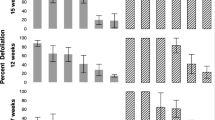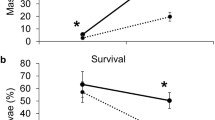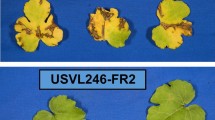Abstract
Solanum chacoense Bitter is resistant to the Colorado potato beetle (CPB),Leptinotarsa decemlineata (Say). Resistance has been associated with the presence of a rare class of glycoalkaloids, the leptines. In this study, seven tetraploid, F2S. tuberosum xS. chacoense families were evaluated for foliar production of leptines I and II, leptinines I and II, and α-solanine and α-chaconine; and screened for resistance to CPB in the laboratory and field. Resistance was correlated with the concentrations of glycoalkaloids on a family and an individual basis. Leptine concentrations ranged from undetectable to a high of 18.0 mg/g dry weight. All of the progeny produced solanine and chaconine. Family 9623 had the highest mean leptine concentration and the lowest mean leaf disk feeding and CPB defoliation levels. Family 9616 had the lowest mean glycoalkaloid concentration and ranked as one of the most susceptible families. Regression analyses of solanine + chaconine, leptine I and II, and leptinine I and II foliar concentrations versus leaf disk consumption and field defoliation revealed that only increased foliar levels of leptines resulted in decreased CPB feeding. The regression models for leptines versus leaf disk consumption and field defoliation were highly significant, accounting for 17% and 26% of the variation in consumption and defoliation, respectively. To the best of our knowledge, this is the first work reporting the impact of leptine and leptinine concentrations on CPB feeding in tetraploid,S. tuberosum xS. chacoense potato hybrids. Results are discussed within the context of breeding for resistance to CPB.
Resumen
Solanum chacoense Bitter es resistente al escarabajo de la papa (CPB),Leptinotarsa decemlineata (Say). La resistencia ha sido asociada con la presencia de una clase rara de glicoalcaloides, los leptinos. En este estudio, siete familias tetraploides, F2S. tubero-sum x S. chacoense fueron evaluadas por la producción foliar de leptinos I y II, leptininos I y II, y α-solanina y ochaconina, y revisadas por su resistencia al escarabajo de la papa en el laboratorio y el campo. La resistencia fue correlacionada con las concentraciones de glicoalcaloides sobre una base familiar e individual. Concentraciones de leptinos se extendieron de no percibidas hasta un máximo de 18.0 mg/g peso seco. Toda la progenie producía solanina y chaconina. La familia 9623 tenía el promedio de concentración más alto de leptinos, y el promedio más bajo tanto para el consumo de discos de hoja, como en los niveles de defoliación por el escarabajo de la papa. La familia 9616 demostro el promedio de concentración más bajo de glicoalcaloides, y se mostró como una de las familias mas susceptibles. Los análisis de regresión de solanina + chaconina, y las concentraciones foliares de leptino I y II, y leptinino I y II contra el consumo de discos de hoja y la defoliación en campo, revelaron que solo los niveles foliares aumentados de leptinos resultaron en una alimentación reducida de parte del escarabajo de la papa. Los modelos de regresión para leptinos contra el consumo de discos de hoja, y la defoliación en el campo, fueron sumamente signifcantes, y explicaron el 17% y el 26% de la variación en el consumo y la defoliación, respectivamente. Que sepamos, este es el primer trabajo que informa del impacto de concentraciones de leptinos y leptininos sobre el consumo que realiza el escarabajo de la papa de los híbridos de papa tetraploides 5.tuberosum x S. chacoense. Los resultados se evalúan dentro del contexto de la crianza para la resistencia al escarabajo de la papa.
Similar content being viewed by others
Literature Cited
Boodley, J.W. and R. Sheldrake. 1982. Cornell peat-lite mixes for commercial plant growing. Cornell Cooperative Extension, Information Bulletin 43.
Fehr, W.R. 1987. Principles of Cultivar Development: Volume 1 Theory and Technique. McGraw Hill, Inc., New York.
Ferro, D.N. 1985. Pest status and control strategies of the Colorado potato beetle. In: D.N. Ferro and R.H. Voss (eds.). Proc. of a Symp. on the Colorado potato beetle, XVIIth Intern. Congress Entomol., Massachusetts Agric Exp Stn Bull, No 704, pp. 1–8.
Kobayashi, R.S., S.L. Sinden, and L.L. Sanford. 1994. Effect of ploidy on foliar glycoalkaloid concentration and Colorado potato beetle resistance inSolanum chacoense. Am Potato J 680 (Abstract).
Kowalski, S.P., J.M. Domek, K.L. Deahl, and L.L Sanford. 1999. Performance of Colorado potato beetle larvae (Leptinotarsa decemlineata Say) reared on synthetic diets supplemented withSolanum glycoalkaloids. Am J Pot Res 76:305–312.
Kuhn, R. and I. Löw. 1961. Zur konstitution der leptine. Chem Beri 94:1088–1095.
Lawson, D.R., R.E. Veilleux, and A.R. Miller. 1993. Biochemistry and geneticsof Solanum chacoense steroidal alkaloids: natural resistance factors to Colorado potato beetle. Current Topics in Bot Res 1:335–352.
Little, T.M. and F.J. Hills. 1978. Agricultural Experimentation: Design and Analysis. John Wiley and Sons, Inc., New York.
Maga, J.A. 1994. Glycoalkaloids in Solanaceae. Food Revs Intern 10:385–418.
McCollum, G.D. and S.L. Sinden. 1979. Inheritance study of tuber glycoalkaloids in a wild potato,Solarium chacoense Bitter. Am Potato J 56:95–113.
Moehns, C.P., P.V. Allen, M. Friedman, and W.R. Belknap. 1997. Cloning and expression of solanidine UDP-glucose glucosyltransferase from potato. Plant J 11:227–236.
Osman, S.F., S.F. Herb, T.J. Fitzpatrick, and P. Schmiediche. 1978. Glycoalkaloid composition of wild and cultivated tuber-bearingSolanum species of potential value in potato breeding programs. J Agric Food Chem 26:1246–1248.
Perlak, F.J., T.B. Stone, Y.M. Muskopf, L.J. Peterson, G.B. Parker, S. McPherson, J. Wyman, S. Love, G. Reed, D. Biever, and D.A. Fischhoff. 1993. Genetically improved potatoes: protection from damage from Colorado potato beetles. Plant Mol Biol 22:313–321.
Ronning, C.M., L.L. Sanford, R.S. Kobayashi, and S.P. Kowalski. 1998. Foliar leptine production in segregating Fl, Inter-Fl, and backcross families ofSolarium chcoense Bitter. Am J Potato Res 75:137–143.
Ronning, C.M., J.R. Stommel, S.P. Kowalski, L.L. Sanford, R.S. Kobayashi, and O. Pineda. 1999. Identification of molecular markers associated with leptine production in a population ofSolarium chacoense Bitter. Theor Appl Genet 1:39–46.
Ruppel, R.F. 1983. Cumulative insect-days as an index of crop protection. J Econ Entomol 76:375–377.
Sanford, L.L., R.S. Kobayashi, K.L. Deahl, and S.L. Sinden. 1996. Segregation of leptines and other glycoalkaloids inSolanum tuberosum (4x) xS. chacoense (4x) crosses. Am Potato J 73:21–33.
Sanford, R.S. Kobayashi, K.L. Deahl, and S.L. Sinden. 1997. Diploid and tetraploidSolanum chacoense genotypes that synthesize leptine glycoalkaloids and deter feeding by Colorado potato beetle. Am Potato J 74:15–21.
Sinden, S.L., L.L. Sanford, and K.L. Deahl. 1986a. Segregation of leptine glycoalkaloids inSolarium chacoense Bitter. J Agric Food Chem 34:372–377.
Sinden, S.L., L.L. Sanford, W.W. Cantelo, and K.L. Deahl. 1986b. Leptine glycoalkaloids and resistance to the Colorado potato beetle (Coleoptera: Chrysomelidae) inSolanum chacoense. Environ Entomol 15:1057–1062.
Sinden, S.L., W.W. Cantelo, L.L. Sanford, and K.L. Deahl. 1991. Allelochemically mediated host resistance to the Colorado potato beetle (Leptinotarsa decemlineata (Say) (Coleoptera: Chiysomelidae). Mem Ent Soc Can 157:19–28.
Stürckow, B. and I. Löw. 1961. [The effects of someSolanum, glycoalkaloids on the Colorado potato beetle.] Entomol Exp Appl 4:133–142 (Translated from German).
Tingey, W.M. 1984. Glycoalkaloids as pest resistance factors. Am Potato J 61:157–167.
Tingey, W.M. and G.C. Yencho. 1994. Insect resistance in potato: a decade of progress.In: G.W. Zehnder, R.K. Jansson, M.L. Powelson and K.V. Raman (eds.). Advances in Potato Pest Biology and Management. APS Press, St. Paul, MN.
Valkonen J.P.T., M. Keskitalo, T. Vasara, and L. Pietila 1996. Potato glycoalkaloids: a burden or a blessing? Crit Rev Plant Sci 15:1–20
Weber, D.C. and D.N. Ferro. 1994. Colorado potato beetle: diverse life history poses challenge to management.In: G.W. Zehnder, R.K. Jansson, M.L. Powelson, and K.V. Raman (eds.). Advances in Potato Pest Biology and Management. APS Press, St. Paul, MN.
Yencho, G.C., M.W. Bonierbale, W.M. Tingey, R.L. Plaisted, and S.D. Tanksley. 1996. Molecular markers locate genes for resistance to the Colorado potato beetle,Leptinotarsa decemlineata in hybridSolanum tuberosum xS. berthaultii potato progenies. Entomol Exp Appl 81:141–154.
Author information
Authors and Affiliations
Corresponding author
Rights and permissions
About this article
Cite this article
Yencho, G.C., Kowalski, S.P., Kennedy, G.G. et al. Segregation of leptine glycoalkaloids and resistance to Colorado potato beetle (Leptinotarsa decemlineata (Say)) in F2Solanum tuberosum (4x) ×S. chacoense (4x) potato progenies. Am. J. Pot Res 77, 167–178 (2000). https://doi.org/10.1007/BF02853941
Received:
Issue Date:
DOI: https://doi.org/10.1007/BF02853941




